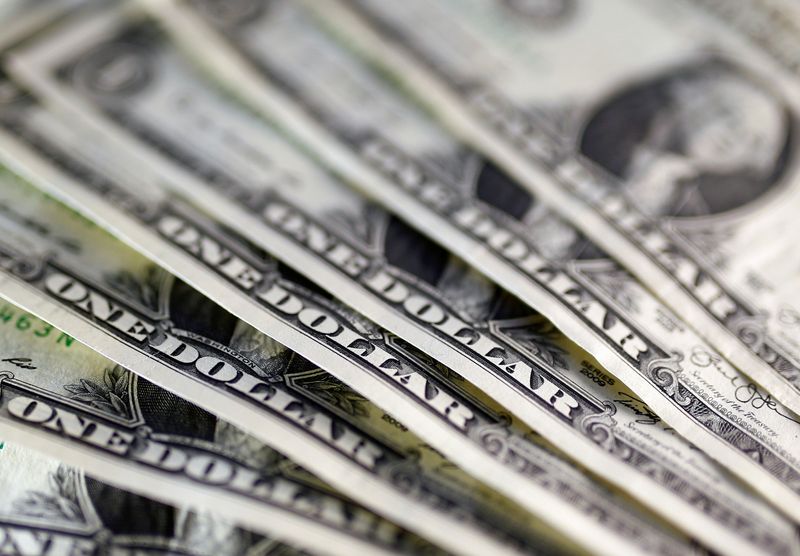By Alun John and Karin Strohecker
LONDON (Reuters) -The dollar fell more than 2% against other major currencies in August, marking its biggest monthly drop this year and providing some relief to economies that have suffered under the weight of dollar strength.
The dollar's downtrend, which has long been anticipated, is driven by expectations that the U.S. Federal Reserve will cut interest rates as the economy weakens.
"The dollar has been under pressure and it will remain under pressure over the remainder of this year," said Guy Miller, chief market strategist, Zurich Insurance Group (OTC:ZFSVF).
Here's where the relief is being felt the most.
1/ YEN INTERVENTION WATCH, CANCELLED
In July, traders braced for Japanese intervention to prop-up a yen that hit 38-year lows against the dollar, a headache for politicians and the Bank of Japan.
But the yen's dramatic rebound has put an end to such intervention speculation.
One dollar is worth 146 yen, down more than 15 yen or around 10% from its mid-July levels, thanks to a BOJ rate hike, looming Fed cuts and a sharp reversal of popular carry trades.
"We're not going to get a rebound in U.S. rates like we've had in previous corrections in the past two years. This is a fundamental turn and dollar/yen is heading lower," said Derek Halpenny, MUFG's head of research global markets EMEA.
It's too late for Japanese Prime Minister Fumio Kishida however. He soon steps down, and the weak yen, which drove up prices, contributed to his undoing.
2/ NEVER HAPPY?
Earlier this year, China tried to stop its currency from weakening too much against the dollar, partly in fear this would drive capital outflows.
But with the yuan at its strongest since June 2023, authorities now fear further strength could cause disruption.
Its rise is largely due to the dollar weakening - China's domestic economy is fragile - but it could continue, especially if exporters sell the hoard of dollars they have accumulated.
"We generally expect that external developments will continue to outweigh domestic drags, and the yuan should gradually move stronger," said ING chief economist for Greater China Lynn Song, forecasting the dollar at 7 yuan by year-end with a fall of around 1% from current levels.
3/ BREATHING SPACE
The weaker dollar has lifted emerging market currencies elsewhere too, especially in Asia. The Philippine peso chalked up its best monthly gains in August in some 18-years and the Indonesian rupiah in more than four years.
That momentum did not spread to Latin America, where Mexico's peso and much of the region suffered hefty losses on domestic woes and wobbly commodity prices.
Nonetheless, a softer dollar coupled with U.S. soft landing hopes provide welcome breathing space for some emerging markets, allowing them more room to cut rates and become more sensitive to domestic growth issues.
"Through the remainder of the year we expect central banks in Philippines, Singapore, South Africa, South Korea, Taiwan and Turkey to join their early-cutter peers in LatAm and (central and Eastern Europe)," said MUFG's head of emerging market research Ehsan Khoman.
4/ FROM FOE TO FRIEND
Two years ago, sterling fell to record lows, partly on political turmoil, while the euro hit parity versus the dollar - moves that exacerbated central banks' inflation battle.
That's now changed and currency strength will likely comfort Bank of England and European Central Bank rate-setters looking to ease policy but mindful of sticky inflation in some parts of the economy.
Sterling and the euro are the top performing major currencies this year. Sterling is above $1.30, up over 25% since its record lows and the euro is above $1.10, supported by markets pricing fewer ECB and BoE rate cuts than for the Fed.
5/ CROWNING MOMENT
Sweden's rate-setters are also likely cheering a weaker dollar.
The Swedish crown has rallied 4% in August, making it the best performing major currency.
It also appreciated versus the euro, helping Sweden to cut rates. Last year Riksbank Governor Eric Thedeen said crown weakness made the inflation fight harder.
It is difficult for Sweden's crown to strengthen further from here, analysts say, but the Norwegian crown could hold up better.

Norway will likely be among the last developed market economies to cut rates, boosting its currency and its sensitivity to global growth.
"In an environment where U.S. interest rates are coming down, U.S. growth slows, but global growth remains stable, high beta (growth sensitive) currencies such as the NOK (Norwegian crown) tend to perform well," NatWest analysts said.